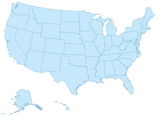- A county of the United States is a local level of government smaller than a state but generally larger than a city or town, in a U.S. state or territory. The actual term "county" describes them in 48 of the 50 states; Louisiana uses the term "parish" and Alaska uses the word "borough." Including those, there are 3,086 counties in the United States, an average of 62 counties per state. The state with the fewest counties is Delaware (three), and the state with the most is Texas (254). In many states, counties are subdivided into townships or towns and may contain other independent, self-governing municipalities.

What's New
|

|
|
|||||
| Lists
of counties by state
|
California borders the
Pacific Ocean,
Oregon,
Nevada,
Arizona, and the
Mexican state of
Baja California. The state has strikingly beautiful natural features,
including an expansive central valley, tall mountains, hot deserts, and
hundreds of miles of scenic coastline. With an area of
411,000
km² it is the third largest state in the U.S and larger than Germany in
size. Most major cities are at or near the Pacific coastline, notably
Los Angeles,
San Francisco,
San Jose,
Long Beach,
Oakland,
Santa Ana/Orange
County, and
San Diego. However, the
capital,
Sacramento, is in the
Central Valley.
California has extremely varied geography. In the center of the state lies the California Central Valley, a huge, fertile valley bounded by the coastal mountain ranges in the west, the granite Sierra Nevada to the east, the volcanic Cascade Range in the north and the Tehachapi Mountains in the south. Mountain-fed rivers, dams, and canals provide water to irrigate the Central Valley. Water supply for much of the state, particularly the more populous cities in Southern California, is provided by the State Water Project. The Central Valley Project also provides municipal water supply, though it primarily provides water supply to irrigated agriculture. With dredging, several of these rivers have become sufficiently large and deep that several inland cities, notably Stockton, are seaports. The hot, fertile Central Valley is California's agricultural heartland and grows a large portion of America's food, yet near freezing temperatures are not uncommon during winter which sometimes wipe out portions of crops. The southern part of the valley, which is part desert, is known as the San Joaquin Valley (drained by the San Joaquin River), while the northern half is known as the Sacramento Valley (drained by the Sacramento River). The Sacramento-San Joaquin Bay Delta is major estuary that supports a brackish ecosystem, while serving as the water supply hub for much of the state's population. |
|||||
|
Get a Free Insurance Quote! | |||||